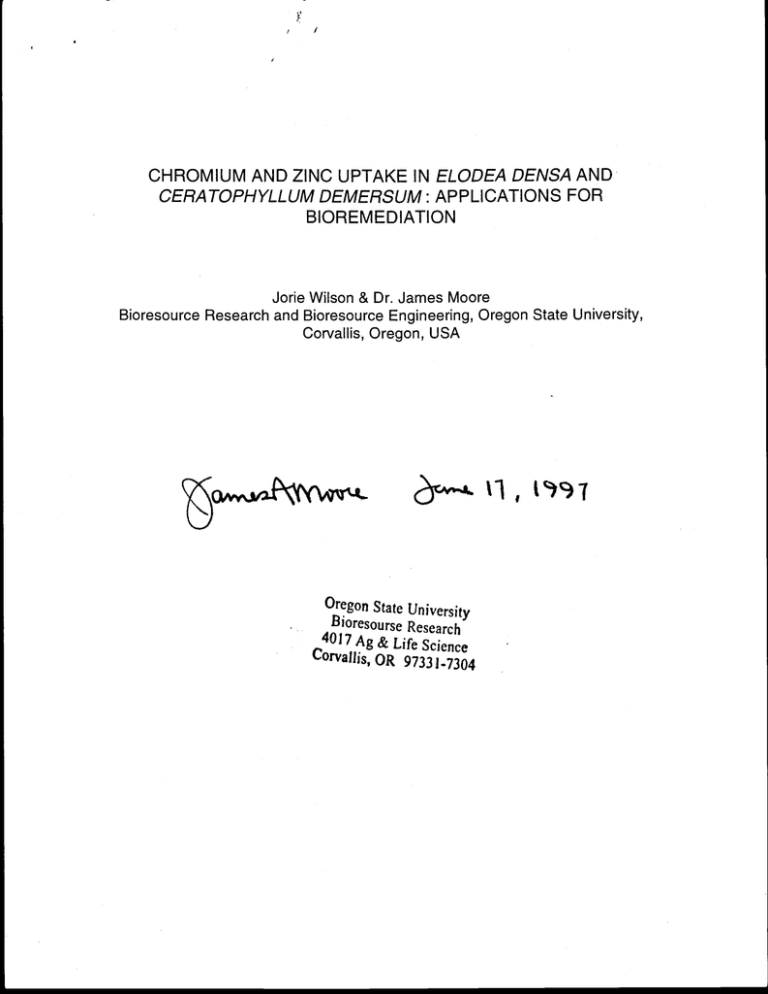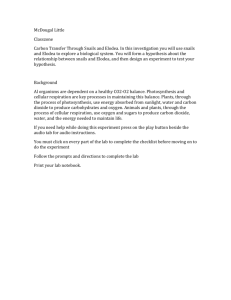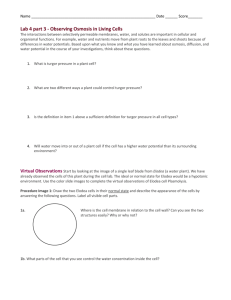CHROMIUM AND ZINC UPTAKE IN ELODEA DENSA AND BIOREMEDIATION
advertisement

CHROMIUM AND ZINC UPTAKE IN ELODEA DENSA AND CERATOPHYLLUM DEMERSUM : APPLICATIONS FOR BIOREMEDIATION Jorie Wilson & Dr. James Moore Bioresource Research and Bioresource Engineering, Oregon State University, Corvallis, Oregon, USA `1C9 Oregon State University Bioresourse Research 4017 Ag & Life Science Corvallis, OR 97331-7304 Abstract South American waterweed, Elodea densa (Planch.) Casp., and Coontail Ceratophyllum demersum L., were studied for their potential to take up chromium and zinc and as a possible indicator of arsenic, cadmium, copper, and lead pollution. Plants were collected from the Willamette River in Oregon and exposed for 48 hours to either zinc or chromium at 0.05 µg/ml, 0.1 µg/ml or 1.0 µg/ml. Dried plant material was digested by using microwave acid digestion and analyzed for heavy metals by using an Induced Coupled Plasma Spectrometer (ICP). Both species showed uptake of zinc and chromium. At the 1.0 µg/mI exposure Elodea densa showed the highest concentration of zinc at 2244.58 µg/g, and the highest concentration of chromium at 41.4975 µg/g. Elodea densa and Ceratophyllum demersum contained copper, lead and cadmium. The highest concentrations were in Elodea densa with copper at 115.101 µg/g, lead at 4.755 µg/g and cadmium at 0.805 pg/g. Introduction Aquatic plants have been investigated for their ability to remove metals to abate pollution, and as an indicator of and treatment for environmental pollution (Pip, 1990; Wells et al., 1980; Muramoto & Oki, 1983). In wetland treatment systems, aquatic plants serve as one of the major mechanisms of heavy-metal removal (Kadlec & Knight, 1996). Plants for these systems are often selected randomly, although differences in performance between species can be demonstrated (Jain et al., 1989 ). 1 Metal tolerant plants can be listed as excluders, or plants with a restricted transport; index plants which reflect soil or water concentrations; and accumulator species whose metal concentration exceeds the normal values for metal concentrations in plants on a paricular soil. (Pierpoint, 1983). Metal tolerance is usually a heritable phenomenon. There is evidence that high level tolerance to different metals in the same plant is genetically independent. Difference in tolerance can be explained by plants having different genes, having alternative alleles, or having the same genes but with different modifier genes (Shaw, 1990). Metal availability can also effect the uptake of heavy metals by organisms. Redox potential, nutrient availability, salinity, light, microbial activity, pH and water hardness have been shown to effect metal availability (Guilizzoni, 1991; FOrstner and Wittmann, 1979). To build effective water treatment systems in the Willamette Valley, local aquatic plants must be compared for their ability to take up pollutants. This study focuses on the uptake of chromium and zinc by Elodea densa (Planch.) Casp., which is a submerged plant growing in the Willamette Valley but originally from South America, and Ceratophyllum demersum L. which is a native submerged forb. I collected these two plants from the Willamette River at Willamette Park in Corvallis, Oregon, and studied their uptake potential when exposed to chromium and zinc at 0.05 µg/ml, 0.1 µg/ml and 1.0 µg/ml . Plants were also tested for arsenic, cadmium, copper, and lead, as an indicator of possible pollution in the Willamette River. 2 Materials and Methods Ceratophyllum demersum and Elodea densa were collected during June, July, and August of 1996 from ponds off the Willamette River in Willamette Park, Corvallis, OR. Plants were stored in outside tanks with tap water until September when they were transferred to 5 gallon buckets of tap water in the greenhouse. Corvallis tap water ranges in pH from 6.7-7.9. Water hardness ranges from 28-40 mg/L of CaCO3. The day temperature was set at approximately 25 °C, or 78 °F; night temperature was set at 20 °C, or 68 OF. For a more realistic summer-type atmosphere artificial lights were suspended over the plants and set for 14 hours of light per day. Seven days before treatment the plants received 360 ml of Murashige and Skoog Basal Salt Mixture at a 1/10 dilution to the plants in 12 liters of tap water. After seven days of exposure in the salt/water solution each species was exposed to chromium K2(CrO4) or zinc Zn(S04) at 0.05 µg/ml , 0.1 µg/ml , or 1.0 µg/ml for 48 hours. Plants were then washed with tap water and dried. Dried plants were ground and approximately 0.25 g of tissue from each sample was weighed into lined digestion vessels (CEM Corporation). To each vessel 2.0 ml of 30% hydrogen peroxide and 0.5 ml of concentrated H(N03) were added. This mixture was digested using a CEM Corporation MDS 2000 Microwave with an acid digestion procedure adapted from Microwave Digestion Theory and Practice ( Robert 0. Miller, U.C. Davis). The resulting solutions were brought up to 10 ml each with deionized water and analyzed for arsenic, cadmium, chromium, copper, lead, and zinc using a PerkinElmer Optima 3000 DV Induced Coupled Plasma Spectrometer. This experiment was repeated a second time to give a total of 28 samples, including 2 control samples for each plant species. 3 Results Standard deviations for the plant uptakes show that Elodea densa had an increase in zinc accumulation between exposures of 0 and 0.05 tg/ml zinc. No significant difference was found in uptake between 0.05 and 0.1 µg/ml . Ceratophyllum demersum showed no significant increase in uptake across the range of zinc exposures (Table 1). Elodea densa showed an increase in chromium uptake for all exposures. Ceratophyllum demersum showed an increase in uptake of chromium between 0 and 0.05 µg/ml , and between 0.1 and 1.0 pg/ml. No increase is shown between 0.05 and 0.1 pg/ml (Table 2). Elodea densa removed more zinc from solution than did Ceratophyllum demersum at 1.0 µg/ml exposure (Figure 1). Elodea densa also removed more chromium from solution at 0.1 and 1.0 µg/ml exposures (Figure 2). Copper, lead, and cadmium concentrations are shown on Tables 3 and 4. Arsenic concentrations were too low to measure accurately. Elodea densa had, on average, a higher concentration of heavy metals than Ceratophyllum demersum. Discussion Zinc concentrations were high initially in both species because of an unknown amount of zinc exposure from unlined holding tanks. Even with an unusually high zinc content, Elodea densa continued to show an increase in uptake during 48-hour exposures. Ceratophyllum demersum did not show a significant increase in zinc during the exposure times, but the concentration in 4 control groups was high, showing uptake ability. Both species appeared healthy after all exposure concentrations. Chromium uptake increased significantly in both species. A previous study showed a much higher uptake of chromium in Ceratophyllum demersum after 48 hours than my study (Garg and Chandra 1990). They recorded at a 0.05 ppm exposure an uptake of 117.7 ± 1.20 µg/g, at 0.1 ppm an uptake of 160.87 ± 0.51 µg/g, and at 1.0 ppm 216.32 ± 0.91 µg/g. These differences may be due to metal availability factors, the age of the plants used, interference of other metals, or differences in tolerance between populations. Garg and Chandra's (1990) study suggested 0.1 µg/ml chromium as a safe exposure limit for Ceratophyllum demersum. Chromium's effects on algae, duckweed, water hyacinth and water lettuce have also been studied (Mangi et al.1978; Stayakala and Jamil 1992). Both species appeared healthy after all exposures to chromium, although further tests would be needed to determine physiological effects and toxic levels for Elodea densa. Both Ceratophyllum demersum and Elodea densa showed potential for heavy metal cleanup in contaminated waters. Because Elodea can be freefloating, it could be used in floating aquatic systems. The lack of a root system in Ceratophyllum could also make this species useful in floating treatment systems and easier to harvest than rooted aquatic plants. Acknowledgments Jim Wernz provided technical support and gave useful information on the ICP Spectrometer and Microwave Acid Digestion's. Dr. Richard Halse gave helpful information and advice on wetland plant species. This work was funded by the D.B. DeLoach Scholarship Fund. 5 References Forstner, U. & Wittmann, G.T.W. (1979). Metal pollution in the aquatic environment. Springer-Verlag, Berlin, Heidelberg. 271-323. Garg, P. & Chandra, P. (1990). Toxicity and accumulation of chromium in Ceratophyllum demersum L. Bull. Environ. Contam. Toxicol. 44: 473-478. Guilizzoni,P. (1991). The role of heavy metals and toxic materials in the physiological ecology of submersed macrophytes. Aquatic Botany. 41:97109. Jain, S.K., Vasudevan, P., & Jha, N.K. (1990). Azolla pinnata R.Br. and Lemna minor L. for removal of lead and zinc from polluted water. Water Res. 24 (2): 177-183. Kadlec, R.H. & Knight, R.L. (1996). Treatment Wetlands. CRC Press Inc., Boca Raton, Florida. 481-519. Mangi, J. et al. (1978). Effects of chromium on some aquatic plants. Environ Pollut. 16: 285-291. Muramoto, S. & Oki, Y. (1983). Removal of some heavy metals from polluted water by water hyacinth (Eichhornia crassipes). Bulletin of Environmental Contamination and Toxicology. 30: 170-177. 6 Pierpoint, R. (1983). Metals and micronutrients: Uptake and utilization by plants. Academic Press Inc., London. 51-69. Pip, E. (1990). Cadmium, copper and lead in aquatic macrophytes in Shoal Lake. Hydrobiologia. 208: 253-260. Wells, J.R., Kaufman, P.B. & Jones, J.D. (1980). Heavy metal contents in some macrophytes from Saginaw Bay (Lake Huron, U.S.A.). Aquatic Botany. 9: 185-193. Satyakala, G. & Jamil, K. (1992). Chromium-induced biochemical changes in Eichhornia crassipes (Mart) Soims and Pistia stratiotes L. Bull. Environ. Contam. Toxicol. 48: 921-928. Shaw, J. A. (1990). Heavy metal tolerance in plants: Evolutionary aspects. CRC Press, Inc. Boca Raton, Florida. 179-253. 7 Table 1. Average concentration (± standard deviation) of zinc and chromium in Elodea densa (µg/g dry wt) after 48 hrs. Exposure (µg/mI) 0 0.05 0.1 1 Zinc (µg/g) 1017.52 ± 17.52 1170.49 ± 93.38 1010.14 ± 249.83 2244.58 ± 27.24 Chromium (µg/g) 2.31 ± 0.20 6.22 ± 1.12 12.57 ± 0.18 41.50 ± 1.93 Table 2. Average concentration (± standard deviation) of zinc and chromium in Ceratophyllum demersum (µg/g dry wt) after 48 hrs. Exposure (µg/ml) 0 0.05 0.1 1 Zinc (µg/g) 1052.27 ±181.32 1063.28 ± 328.16 1282.12 ± 262.70 1511.73 ± 440.33 Chromium (µg/g) 1.56 ±0.08 5.16 ± 1.03 6.05 ± 1.42 26.83 ± 3.49 Table 3. Average concentration (± standard deviation) of heavy metals in Elodea densa (µg/g dry wt.) Copper Lead Cadmium 115.1 4.76 0.81 ±78.42 ±2.33 ±0.97 Table 4. Average concentration (± standard deviation) of heavy heavy metals in Ceratophyllum demersum (µg/g dry wt.) Copper 61.40 ±28.41 Lead 2.35 Cadmium 0.18 ±3.33 ±0.07 - Elodea 2500 T -F Ceratophyllum 2000 1500 500 + 0 O T- O N O O O O O O O O rn O Exposure (ppm) Figure 1. Zinc concentration in plants --- Elodea - i - Ceratophyllum O T O N O CO O d, O IC) C0 O O I- O CO 0) O O Exposure (ppm) Figure 2. Chromium concentration in plants T






